外文翻译--制冷技术发展的历史-精品
制冷空调技术的发展与应用
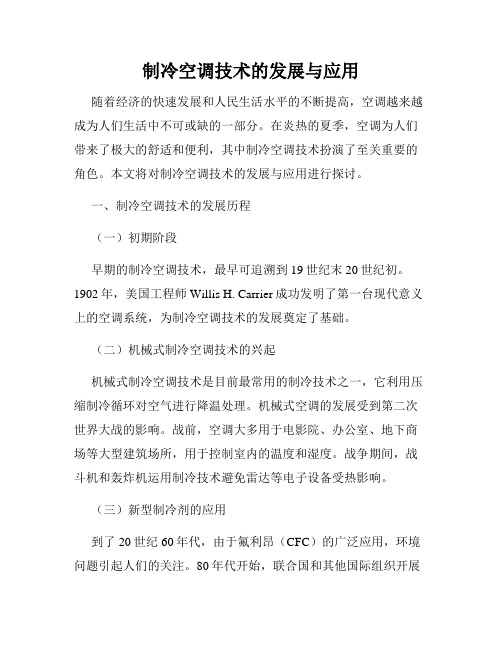
制冷空调技术的发展与应用随着经济的快速发展和人民生活水平的不断提高,空调越来越成为人们生活中不可或缺的一部分。
在炎热的夏季,空调为人们带来了极大的舒适和便利,其中制冷空调技术扮演了至关重要的角色。
本文将对制冷空调技术的发展与应用进行探讨。
一、制冷空调技术的发展历程(一)初期阶段早期的制冷空调技术,最早可追溯到19世纪末20世纪初。
1902年,美国工程师Willis H. Carrier成功发明了第一台现代意义上的空调系统,为制冷空调技术的发展奠定了基础。
(二)机械式制冷空调技术的兴起机械式制冷空调技术是目前最常用的制冷技术之一,它利用压缩制冷循环对空气进行降温处理。
机械式空调的发展受到第二次世界大战的影响。
战前,空调大多用于电影院、办公室、地下商场等大型建筑场所,用于控制室内的温度和湿度。
战争期间,战斗机和轰炸机运用制冷技术避免雷达等电子设备受热影响。
(三)新型制冷剂的应用到了20世纪60年代,由于氟利昂(CFC)的广泛应用,环境问题引起人们的关注。
80年代开始,联合国和其他国际组织开展了一系列研究,证实氟利昂(CFC)是对大气臭氧层造成破坏的主要物质之一。
于是,随着环保意识的提高,制冷剂的特点开始引起重视。
制冷空调行业的改革创新也随之而来,相关行业开始积极探索新型制冷剂的应用,研制出更加环保、高效的制冷空调系统。
(四)智能化技术的运用智能化制冷空调技术以其高效、环保、节能、智能等特点广受人们青睐。
智能空调采用了先进的可控技术,使得空调可以根据室内外环境传感器、空气品质传感器、热负荷等数据自动地进行调节和优化,达到更舒适的室内环境,消耗更少的能源和环保的目的。
二、制冷空调技术的应用现状随着消费者环保意识的提高与科技创新的加速,制冷空调技术的应用范围也愈加广泛。
目前主要的应用领域如下:(一)家庭用空调目前,家用空调已形成分体、中央空调、窗式空调三种类别。
分体空调采用室内外分开设计,可以更加灵活、省空间地布局。
冷库制冷技术发展历程

冷库制冷技术发展历程冷库,作为冷链物流系统的重要组成部分,扮演着保鲜、储存和运输食品的关键角色。
而冷库制冷技术的发展历程也是一个不断创新和演进的过程。
一、初期冷库制冷技术冷库制冷技术的起源可以追溯到19世纪末,当时人们主要采用冰块或冰雪来进行食品储存。
这种方法虽然简单,但存在着存储时间短、不易控制温度等问题。
二、机械制冷技术的引入20世纪初,机械制冷技术的引入为冷库制冷技术的发展带来了革命性的变化。
人们开始使用压缩机和蒸发器等设备,通过制冷剂的循环来实现冷库的制冷效果。
这种技术使得冷库的制冷能力大幅提升,储存时间也得到了延长。
三、氨制冷技术的应用随着对环境污染和能源消耗的关注,人们开始寻求更加环保和高效的制冷技术。
氨制冷技术由此应运而生。
氨是一种无毒、无污染的制冷剂,具有良好的制冷性能和高效的制冷效果。
氨制冷技术的应用使得冷库制冷更加环保可持续,并且在大规模冷库中得到了广泛应用。
四、冷库自动控制技术随着计算机和自动控制技术的不断发展,冷库制冷技术也得到了进一步提升。
现代冷库普遍采用自动控制系统,通过传感器实时监测冷库内的温度、湿度等参数,并通过控制阀门、压缩机等设备来自动调节制冷效果。
这种技术不仅提高了冷库的稳定性和精确度,还降低了人工操作的需求。
五、新型制冷技术的应用近年来,随着科技的不断进步,新型制冷技术也逐渐应用于冷库制冷领域。
例如,吸附式制冷技术利用吸附剂吸附和释放制冷剂来实现冷库的制冷效果,具有低能耗、低噪音等优点。
另外,磁制冷技术、超导制冷技术等也在冷库制冷中得到了尝试和应用。
六、冷库能源管理技术随着能源问题的日益突出,冷库能源管理技术成为了制冷行业发展的重要方向。
通过对冷库能源消耗的监测和优化,提高制冷效率,减少能源浪费。
智能化的能源管理系统可以根据需求进行灵活调控,实现节能效果。
冷库制冷技术经历了从简单的冰块储存到机械制冷、氨制冷、自动控制等多个阶段的发展。
新型制冷技术的应用和冷库能源管理技术的发展也为冷库制冷提供了更加高效和可持续的解决方案。
外文翻译--空调与制冷技术
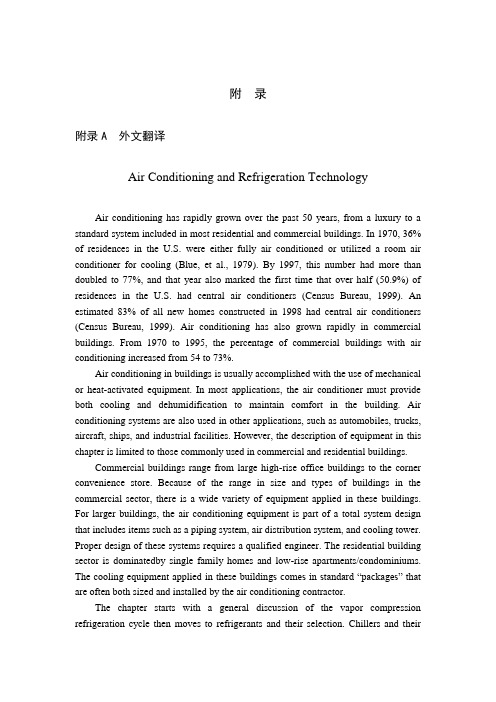
附录附录A 外文翻译Air Conditioning and Refrigeration TechnologyAir conditioning has rapidly grown over the past 50 years, from a luxury to a standard system includedin most residential and commercial buildings. In 1970, 36% of residences in the U.S. were either fullyair conditioned or utilized a room air conditioner for cooling (Blue, et al., 1979). By 1997, this numberhad more than doubled to 77%, and that year also marked the first time that over half (50.9%) ofresidences in the U.S. had central air conditioners (Census Bureau, 1999). An estimated 83% of all newhomes constructed in 1998 had central air conditioners (Census Bureau, 1999). Air conditioning has alsogrown rapidly in commercial buildings. From 1970 to 1995, the percentage of commercial buildings withair conditioning increased from 54 to 73%.Air conditioning in buildings is usually accomplished with the use of mechanical or heat-activatedequipment. In most applications, the air conditioner must provide both cooling and dehumidificationto maintain comfort in the building. Air conditioning systems are also used in other applications, suchas automobiles, trucks, aircraft, ships, and industrial facilities. However, the description of equipment inthis chapter is limited to those commonly used in commercial and residential buildings.Commercial buildings range from large high-rise office buildings to the corner convenience store.Because of the range in size and types of buildings in the commercial sector, there is a wide variety ofequipment applied in these buildings. For larger buildings, the air conditioning equipment is part of atotal system design that includes items such as a piping system, air distribution system, and cooling tower.Proper design of these systems requires a qualified engineer. The residential building sector is dominatedby single family homes and low-rise apartments/condominiums. The cooling equipment applied in thesebuildings comes in standard “packages” that are often both sized and installed by the air conditioningcontractor.The chapter starts with a general discussion of the vapor compressionrefrigeration cycle then movesto refrigerants and their selection. Chillers and their auxiliary systems are then covered, followed bypackaged air conditioning equipment.Even though there is a large range in sizes and variety of air conditioning systems used in buildings, mostsystems utilize the vapor compression cycle to produce the desired cooling and dehumidification. Thiscycle is also used for refrigerating and freezing foods and for automotive air conditioning. The first patenton a mechanically driven refrigeration system was issued to Jacob Perkins in 1834 inLondon, and the firstviable commercial system was produced in 1857 by James Harrison and D.E. Siebe (Thevenot 1979).Besides vapor compression, there are two less common methods used to produce cooling in buildings:the absorption cycle and evaporative cooling. These are described later in the chapter. With the vaporcompression cycle, a working fluid, which is called the refrigerant, evaporates and condenses at suitablepressures for practical equipment designs.The four basic components in every vapor compression refrigeration system are thecompressor, condenser, expansion device, and evaporator. The compressor raises the pressure of therefrigerant vapor so that the refrigerant saturation temperature is slightly above the temperature of thecooling medium used in the condenser. The type of compressor used depends on the application of thesystem. Large electric chillers typically use a centrifugal compressor while small residential equipmentuses a reciprocating or scroll compressor.The condenser is a heat exchanger used to reject heat from the refrigerant to a cooling medium. Therefrigerant enters the condenser and usually leaves as a subcooled liquid. Typical cooling mediums usedin condensers are air and water. Most residential-sized equipment uses air as the cooling medium in thecondenser, while many larger chillers use water.After leaving the condenser, the liquid refrigerant expands to a lower pressure in the expansion valve.The expansion valve can be a passive device, such as a capillary tube or short tube orifice, or an activedevice, such as a thermal expansion valve or electronic expansion valve. The purpose of the valve is toregulate the flow of refrigerant to the evaporator so that the refrigerant is superheated when it reachesthe suction of the compressor.At the exit of the expansion valve, the refrigerant is at a temperature below that of the medium (air orwater) to be cooled. The refrigerant travels through a heat exchanger called the evaporator. It absorbsenergy from the air or water circulated through the evaporator. If air is circulated through the evaporator,the system is called a direct expansion system. If water is circulated through the evaporator, it is calledachiller. In either case, the refrigerant does not make direct contact with the air or water in the evaporator.The refrigerant is converted from a low quality, two-phase fluid to a superheated vapor under normaloperating conditions in the evaporator. The vapor formed must be removed by the compressor at asufficient rate to maintain the low pressure in the evaporator and keep the cycle operating.All mechanical cooling results in the production of heat energy that must be rejected through thecondenser. In many instances, this heat energy is rejected to the environment directly to the air in thecondenser or indirectly to water where it is rejected in a cooling tower. With some applications, it ispossible to utilize this waste heat energy to provide simultaneous heating to the building. Recovery ofthis waste heat at temperatures up to 65°C (150°F) can be used to reduce costs for space heating.Capacities of air conditioning are often expressed in either tons or kilowatts (kW) of cooling. The tonis a unit of measure related to the ability of an ice plant to freeze one short ton (907 kg) of ice in 24 hr.Its value is 3.51 kW (12,000 Btu/hr). The kW of thermal cooling capacity produced by the air conditionermust not be confused with the amount of electrical power (also expressed in kW) required to producethe cooling effect.Refrigerants Use and SelectionUp until the mid-1980s, refrigerant selection was not an issue in most building air conditioning applicationsbecause there were no regulations on the use of refrigerants. Many of the refrigerants historicallyused for building air conditioning applications have been chlorofluorocarbons (CFCs) and hydrochlorofluorocarbons(HCFCs). Most of these refrigerants are nontoxic and nonflammable. However,recent U.S. federal regulations (EPA 1993a; EPA 1993b) and international agreements (UNEP, 1987) haveplaced restrictions on the production and use of CFCs and HCFCs. Hydrofluorocarbons (HFCs) are nowbeing used in some applications where CFCs and HCFCs were used. Having an understanding ofrefrigerants can help a building owner or engineer make a more informed decision about the best choiceof refrigerants for specific applications. This section discusses the different refrigerants used in or proposedfor building air conditioning applications and the regulations affecting their use.The American Society of Heating, Refrigerating and Air Conditioning Engineers (ASHRAE) has astandard numbering system (Table 4.2.1) for identifying refrigerants (ASHRAE, 1992). Many popularCFC, HCFC, and HFC refrigerants are in the methane and ethane series of refrigerants. They are calledhalocarbons, or halogenated hydrocarbons, because of the presence of halogen elements such as fluorineorchlorine (King, 1986).Zeotropes and azeotropes are mixtures of two or more different refrigerants. A zeotropic mixture changessaturation temperatures as it evaporates (or condenses) at constant pressure. The phenomena is calledtemperature glide. At atmospheric pressure, R-407C has a boiling (bubble) point of –44°C (–47°F) and acondensation (dew) point of –37°C (–35°F), which gives it a temperature glide of 7°C (12°F). An azeotropicmixture behaves like a single component refrigerant in that the saturation temperature does not changeappreciably as it evaporates or condenses at constant pressure. R-410A has a small enough temperatureglide (less than 5.5°C, 10°F) that it is considered a near-azeotropic refrigerant mixture.ASHRAE groups refrigerants (Table 4.2.2) by their toxicity and flammability (ASHRAE, 1994).Group A1 is nonflammable and least toxic, while Group B3 is flammable and most toxic. Toxicity isbased on the upper safety limit for airborne exposure to the refrigerant. If the refrigerant is nontoxicin quantities less than 400 parts per million, it is a Class A refrigerant. If exposure to less than 400 partsper million is toxic, then the substance is given the B designation. The numerical designations referto the flammability of the refrigerant. The last column of Table 4.2.1 shows the toxicity and flammabilityrating of common refrigerants.Refrigerant 22 is an HCFC, is used in many of the same applications, and is still the refrigerant ofchoice in many reciprocating and screw chillers as well as small commercial and residential packagedequipment. It operates at a much higher pressure than either R-11 or R-12. Restrictions on the productionof HCFCs will start in 2004. In 2010, R-22 cannot be used in new air conditioning equipment. R-22cannot be produced after 2020 (EPA, 1993b).R-407C and R-410A are both mixtures of HFCs. Both are considered replacements for R-22. R-407Cis expected to be a drop-in replacement refrigerant for R-22. Its evaporating and condensing pressuresfor air conditioning applications are close to those of R-22 (Table 4.2.3). However, replacement of R-22with R-407C should be done only after consulting with the equipment manufacturer. At a minimum,the lubricant and expansion device will need to be replaced. The first residential-sized air conditioningequipment using R-410A was introduced in the U.S. in 1998. Systems using R-410A operate at approximately50% higher pressure than R-22 (Table 4.2.3); thus, R-410A cannot be used as a drop-in refrigerantfor R-22. R-410A systems utilize compressors, expansion valves, and heat exchangers designed specificallyfor use with that refrigerant.Ammonia is widely used in industrial refrigeration applications and in ammonia water absorptionchillers. It is moderately flammable and has a class B toxicity ratingbut has had limited applications incommercial buildings unless the chiller plant can be isolated from the building being cooled (Toth, 1994,Stoecker, 1994). As a refrigerant, ammonia has many desirable qualities. It has a high specific heat andhigh thermal conductivity. Its enthalpy of vaporization is typically 6 to 8 times higher than that of thecommonly used halocarbons, and it provides higher heat transfer compared to halocarbons. It can beused in both reciprocating and centrifugal compressors.Research is underway to investigate the use of natural refrigerants, such as carbon dioxide (R-744)and hydrocarbons in air conditioning and refrigeration systems (Bullock, 1997, and Kramer, 1991).Carbon dioxide operates at much higher pressures than conventional HCFCs or HFCs and requiresoperation above the critical point in typical air conditioning applications. Hydrocarbon refrigerants,often thought of as too hazardous because of flammability, can be used in conventional compressors andhave been used in industrial applications. R-290, propane, has operating pressures close to R-22 and hasbeen proposed as a replacement for R-22 (Kramer, 1991). Currently, there are no commercial systemssold in the U.S. for building operations that use either carbon dioxide or flammable refrigerants.From:Composite Index Ashrae Handbook Series空调与制冷技术过去50年以来,空调得到了快速的发展,从曾经的奢侈品发展到可应用于大多数住宅和商业建筑的比较标准的系统。
制冷英文-
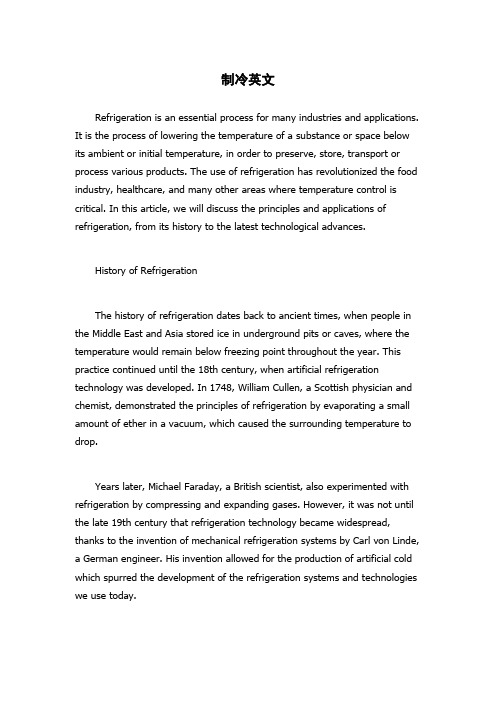
制冷英文Refrigeration is an essential process for many industries and applications. It is the process of lowering the temperature of a substance or space below its ambient or initial temperature, in order to preserve, store, transport or process various products. The use of refrigeration has revolutionized the food industry, healthcare, and many other areas where temperature control is critical. In this article, we will discuss the principles and applications of refrigeration, from its history to the latest technological advances.History of RefrigerationThe history of refrigeration dates back to ancient times, when people in the Middle East and Asia stored ice in underground pits or caves, where the temperature would remain below freezing point throughout the year. This practice continued until the 18th century, when artificial refrigeration technology was developed. In 1748, William Cullen, a Scottish physician and chemist, demonstrated the principles of refrigeration by evaporating a small amount of ether in a vacuum, which caused the surrounding temperature to drop.Years later, Michael Faraday, a British scientist, also experimented with refrigeration by compressing and expanding gases. However, it was not until the late 19th century that refrigeration technology became widespread, thanks to the invention of mechanical refrigeration systems by Carl von Linde, a German engineer. His invention allowed for the production of artificial cold which spurred the development of the refrigeration systems and technologies we use today.Principles of RefrigerationThe principles of refrigeration are based on two basic thermodynamics principles, namely the first and second law of thermodynamics. The first law states that energy cannot be created or destroyed but can be converted from one form to another. The second law states that energy will always flow from a higher to a lower temperature. These two principles provide the foundation of refrigeration technology.The refrigeration cycle consists of four main components: a compressor, condenser, expansion valve and an evaporator. The compressor compresses the refrigerant gas and raises its temperature, which is then cooled in the condenser by removing heat from the refrigerant to the environment. The cooled refrigerant is then passed through the expansion valve, which reduces its pressure and causes it to evaporate in the evaporator. The heat from the substance or space being cooled is absorbed during this process, and the low-pressure gas is then sent back to the compressor to begin the cycle again.Applications of RefrigerationThere are many applications of refrigeration technology in various industries, some of which include the following:1. Food and Beverage Industry: Refrigeration is essential for preserving, storing and transporting perishable food items such as fresh fruits and vegetables, meat, dairy products and beverages. This has a direct impact on the quality, safety, and shelf life of these products.2. Healthcare Industry: Refrigeration is also vital in furnishing medical services to ensure that vaccines, drugs, and other temperature-sensitive medical supplies are transported and stored under the appropriate conditions to avoid contamination and degradation.3. Agriculture Industry: Refrigeration technology has revolutionized the agriculture industry by allowing farmers to store their produce for longer periods, ensuring that it remains fresh and in good condition until it reaches the market.4. Chemical Industry: Refrigeration is used in the chemical industry to cool raw materials, allowing them to be processed more effectively.5. Automotive Industry: Refrigeration is used to cool the engine and air conditioning systems in vehicles.Technological Advances in RefrigerationRefrigeration technology has come a long way from the early days of ice storage. The latest technological advancements in refrigeration include the following:1. Smart Refrigeration Systems: The use of advanced sensors and control systems has made it possible to monitor and adjust the temperature and humidity of refrigerated spaces to ensure optimal conditions.2. Alternative Refrigerants: Due to the environmental impacts of traditional refrigerants, new alternative refrigerants such as carbon dioxide, ammonia and hydrocarbons are being developed.3. Magnetic Refrigeration: This technology uses magnetic fields to cool substances, which is more energy-efficient and environmentally friendly than traditional refrigeration.4. Cryogenic Refrigeration: This technology is used to cool substances to extremely low temperatures using liquid nitrogen or other cryogens.ConclusionRefrigeration is an essential process that has revolutionized various industries and applications. From the early days of ice storage to the latest technological advancements, refrigeration technology has come a long way. With the development of smart refrigeration systems, alternative refrigerants, magnetic refrigeration and cryogenic refrigeration, refrigeration technology is poised for even greater advances and applications, which will have a significant impact on industries and society as a whole.。
制冷技术(英文版)Ch2-090528

Part 2. The Principles of Refrigeration ( 116 pages)Chapter 2. Thermodynamic Analysis of refrigeration cycle2-1) The Laws of Thermodynamics and Their Relation to RefrigerationThermodynamics are primarily concerned with two forms of energy: heat and work. Therefore Engineering Thermodynamics is the study of the interrelation between heat, work, and internalenergy.There are two important concepts of thermodynamic analysis: System and Environment.A system(系统、体系)is defined as any quantity of matter or region of space to which attentionis directed for purpose of analysis;and everything outside the system boundary is referred to as the environment(环境).[1,2] (1)The 0th Law of ThermodynamicsThe Zeroth Law of Thermodynamics states: 热平衡定律—温度定义1.If two systems are each equal in temperature to a third system, then the temperatures of the twosystems themselves are equal.2.If two closed systems (together isolated), with different temperatures are brought into thermalcontact, then the temperatures of the two systems will change to approach the same temperature.That is, the temperature of the system which is at a higher temperature will decrease and thetemperature of the system with the lower temperature will increase. They will eventually have the same temperature.热力学第零定律的重要性在于它给出了温度的定义和温度的测量方法。
制冷原理(中英文对照)
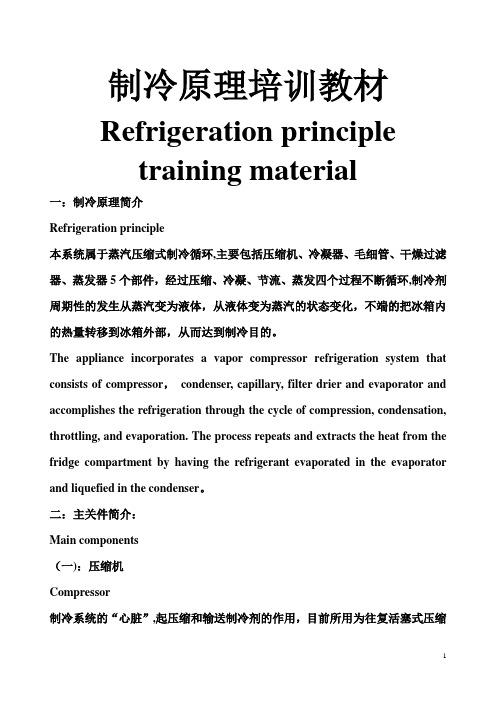
制冷原理培训教材Refrigeration principletraining material一:制冷原理简介Refrigeration principle本系统属于蒸汽压缩式制冷循环,主要包括压缩机、冷凝器、毛细管、干燥过滤器、蒸发器5个部件,经过压缩、冷凝、节流、蒸发四个过程不断循环,制冷剂周期性的发生从蒸汽变为液体,从液体变为蒸汽的状态变化,不端的把冰箱内的热量转移到冰箱外部,从而达到制冷目的。
The appliance incorporates a vapor compressor refrigeration system that consists of compressor,condenser, capillary, filter drier and evaporator and accomplishes the refrigeration through the cycle of compression, condensation, throttling, and evaporation. The process repeats and extracts the heat from the fridge compartment by having the refrigerant evaporated in the evaporator and liquefied in the condenser。
二:主关件简介:Main components(一):压缩机Compressor制冷系统的“心脏”,起压缩和输送制冷剂的作用,目前所用为往复活塞式压缩机.Serving as the heart of the refrigeration system,the compressor functions through compressing and passing the refrigerant. A reciprocal compressor is adopted in the system。
制冷技术的发展历史
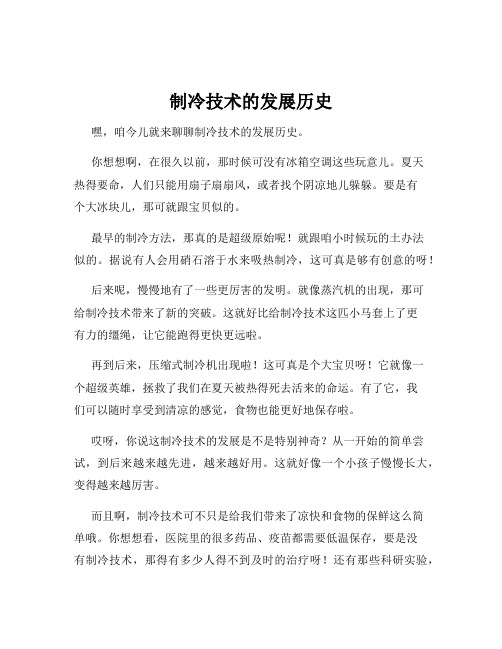
制冷技术的发展历史嘿,咱今儿就来聊聊制冷技术的发展历史。
你想想啊,在很久以前,那时候可没有冰箱空调这些玩意儿。
夏天热得要命,人们只能用扇子扇扇风,或者找个阴凉地儿躲躲。
要是有个大冰块儿,那可就跟宝贝似的。
最早的制冷方法,那真的是超级原始呢!就跟咱小时候玩的土办法似的。
据说有人会用硝石溶于水来吸热制冷,这可真是够有创意的呀!后来呢,慢慢地有了一些更厉害的发明。
就像蒸汽机的出现,那可给制冷技术带来了新的突破。
这就好比给制冷技术这匹小马套上了更有力的缰绳,让它能跑得更快更远啦。
再到后来,压缩式制冷机出现啦!这可真是个大宝贝呀!它就像一个超级英雄,拯救了我们在夏天被热得死去活来的命运。
有了它,我们可以随时享受到清凉的感觉,食物也能更好地保存啦。
哎呀,你说这制冷技术的发展是不是特别神奇?从一开始的简单尝试,到后来越来越先进,越来越好用。
这就好像一个小孩子慢慢长大,变得越来越厉害。
而且啊,制冷技术可不只是给我们带来了凉快和食物的保鲜这么简单哦。
你想想看,医院里的很多药品、疫苗都需要低温保存,要是没有制冷技术,那得有多少人得不到及时的治疗呀!还有那些科研实验,很多都需要在特定的温度下进行,没有制冷技术的支持,那很多科研成果可能都出不来呢!现在的制冷技术啊,那真的是五花八门,各式各样。
有家用的冰箱、空调,还有大型的冷库、冷藏车。
这就像是一个庞大的制冷家族,每个成员都有自己独特的本领和用处。
咱再想想未来,制冷技术肯定还会有更大的发展。
说不定以后的冰箱可以自己识别食物,自动调节温度呢!或者空调可以根据人的体温和心情来调整温度和风速,哇,那可真是太酷啦!总之啊,制冷技术的发展历史就是一部人类追求舒适和便利的历史。
它让我们的生活变得更加美好,更加丰富多彩。
咱可得好好感谢那些为制冷技术发展做出贡献的人们呀!就这么着吧!。
冷冻技术的历史 雅思

冷冻技术的历史雅思The history of freezing technology dates back to ancient times when people used natural ice and snow to preserve food. However, the development of modern freezing techniques has revolutionized the food industry, medicine, and various other fields. The process of freezing involves lowering the temperature of a substance to below its freezing point, thereby preserving it by inhibiting the growth of microorganisms and slowing down chemical reactions. This essay will delve into the historical evolution of freezing technology, its impact on society, and the future potential of this innovation.Freezing as a method of food preservation has been practiced for centuries. In ancient civilizations, people stored food in ice caves or used snow and ice to keep food fresh. However, the invention of the first artificial refrigeration system in the 19th century marked a significant milestone in the history of freezing technology. This breakthrough allowed for the mass production and distribution of frozen food, transforming the way people consumed and preserved food. The ability to freeze food on an industrial scale not only extended theshelf life of perishable items but also enabled the transportation of food over long distances, reducing food waste and ensuring a more stable food supply.The impact of freezing technology extends beyond the realm of food preservation. In the field of medicine, freezing techniques such as cryotherapy have been utilized for various purposes, including the removal of abnormal tissue, treatment of skin conditions, and preservation of biological samples. The ability to freeze and store biological materials has revolutionized medical research and organ transplantation, as it allows for the long-term preservation of tissues and organs, thereby saving countless lives.Moreover, freezing technology has also played a crucial role in the development of the aerospace industry. The ability to preserve and store food for extended periods has been essential for space missions, enabling astronauts to have access to nutritious meals during their journeys. Furthermore, freezingtechnology has been instrumental in the storage and transportation of sensitive materials such as pharmaceuticals, chemicals, and electronics, ensuring their integrity and quality.Looking ahead, the future potential of freezing technology is vast. With ongoing advancements in cryopreservation, there is growing interest in the possibility of preserving whole organisms, including humans, at ultra-low temperatures for potential revival in the future. While this concept remains highly speculative, it raises profound ethical and philosophical questions about the nature of life and the boundaries of medical science.In conclusion, the history of freezing technology is a testament to human ingenuity and innovation. From its humble origins in ancient times to its widespread applications in the modern world, freezing technology has had a profound impact on society, revolutionizing the way we preserve food, conduct medical procedures, and explore outer space. As we continue to unlock the potential of freezing technology, it is essential to consider the ethical implications and ensure that its benefits are harnessed for the betterment of humanity.。
- 1、下载文档前请自行甄别文档内容的完整性,平台不提供额外的编辑、内容补充、找答案等附加服务。
- 2、"仅部分预览"的文档,不可在线预览部分如存在完整性等问题,可反馈申请退款(可完整预览的文档不适用该条件!)。
- 3、如文档侵犯您的权益,请联系客服反馈,我们会尽快为您处理(人工客服工作时间:9:00-18:30)。
制冷技术发展的历史
在史前时代,人类已经发现在食物缺少的季节里,如果把猎物保存在冰冷的地窖里或埋在雪里,就能保存更长的时间。
在中国,早在先秦时代已经懂得了采冰,储冰技术。
希伯来人,古希腊人和古罗马人把大量的雪埋在储藏室下面的坑中,然后用木板和稻草来隔热,古埃及人在土制的罐子里装满开水,并把这些罐子放在他们上面,这样使罐子抵挡夜里的冷空气。
在古印度,蒸发制冷技术也得到了应用。
当一种流体快速蒸发时,它迅速膨胀,升起的蒸汽分子的动能迅速增加,而增加的能量来自周围的环境中,周围环境的温度因此而降低。
在中世纪时期,冷却食物是通过在水中加入某种化学物质像硝酸钠或硝酸钾,而使温度降低,1550年记载冷却酒就是通过这种方法。
这就是制冷工艺的起源。
在法国冷饮是在1660年开始流行的。
人们用装有溶解的硝石的长颈瓶在水里旋转来使水冷却。
这个方法可以产生非常低的温度并且可以制冰。
在17世纪末,带冰的酒和结冻的果汁在法国社会已非常流行。
第一次记载的人工制冷是在1784年,威廉库伦在格拉斯各大学作了证明。
库伦让乙基醚蒸汽进入一个部分真空的容器,但是他没有把这种结果用于任何实际的目的。
在1799年冰第一次被用作商业目的,从纽约市的街道运河运往卡洛林南部的查尔斯顿市,但遗憾的是当时没有足够的冰来装运。
英格兰人Frederick Tuder和Nathaniel Wyeth看到了制冰行业的巨大商机,并且在18世纪上半叶,通过自己的努力革新了这个行业。
Tudor主要从事热带地区运冰,他尝试着安装隔热材料和修建冰房,从而使冰的融化量从66%减少到8%,Wyeth发明了一种切出相同冰块的方法,即快速又便捷,从而使制冰业发生了革命性变化,同时也减少了仓储业,运输业和销售业由于管理技术所造成的损失。
在1805年,一名美国发明者Oliver Evans设计了第一个用蒸汽代替液体的制冷系统,但Evans从来没有制造出这种机器。
不过美国的一位内科医生John. Gorrie制造了一个相似的制冷机器。
在1842年,弗洛雷达医院的这名美国内科医生John. Gorrie为了给黄热病患者治疗,他设计和制造了一台空气冷却装置给病房降温。
他的基本原理是:压缩一种气体,通过盘管使它冷却,然后膨胀使其温度进一步降低,这也就是今天用得最多的制冷器。
后来John. Gorrie停止仅在医院的实践,长期的深入到制冰实验中,在1851年获得关于机械制冰的第一项专利。
商业制冷被认为是起源于1856年,一名美国商人Alexander. C. Twinning 最先开创。
不久,一名澳大利亚人James Harrison检验了Gorrie和Twinning 所用的制冷机并把蒸汽压缩式制冷机介绍给了酿造和肉类食品公司。
在1859年,法国的Fredinad. Carre发明了一种更加复杂的制冷系统。
不
(氨像以前的压缩机用空气做制冷剂,Garre的设备用快速蒸发的氨做制冷剂。
比水液化时的温度低,因此可以吸收更多的热量)Garre的制冷机得到了广泛应用,并且蒸汽压缩式制冷至今仍是应用最广泛地的制冷方法。
但是当时这种制冷机成本高,体积大,系统复杂,再加上氨制冷济有毒性,因此阻碍了这种制冷机在家庭中的普遍应用。
许多家庭的冰柜仍使用当地制冷工厂提供的冰块。
从1840年开始,运输牛奶和黄油用到了空调汽车。
到1860年,制冷技术主要运用在海产品和日常用品的冷藏运输上。
1876年底特律市密歇根州的一名叫J.B Sutherland的人获得了人工制冷汽车专利。
他设计了一种带有冰室的绝热汽车。
空气从顶部流过来,通过冰室,利用重力然后在汽车内循环。
在1867年,伊利诺斯州的Parker Earle制造了第一辆用来运输水果的空调汽车,通过伊利诺斯州中央铁路运送草莓。
每个箱子里装100磅冰和200夸脱草莓。
直到1949年Fred Jones发明了一种顶置式制冷装置,并获得了专利。
1870年,在纽约的布鲁克林镇,S. Liebmanns 的太阳酿造公司开始用吸收式机械,这是美国北部酿造业广泛运用制冷机械的一个开端。
在18世纪70年代,商业制冷在啤酒厂中占主要的地位。
到了1891年,几乎所有的啤酒厂都装配有制冷机器。
天然冰供应本身已发展成为一个行业,许多公司都跻身该行业,导致价格下降。
并且冷藏用冰已相当普遍,到了1879年,在美国有35家商业制冰厂,10年之后就超过了200家,到了1909年达2000家。
所有因制冰废弃的池塘不再安全,甚至Thoreaus Walden池塘,1847年每天有1000吨的冰从那里抽取。
但是,随着时间推移,冰不仅作为冷藏的代名词,也变成了健康问题。
《热与冷》的合著者,Bern Nagengast说:“好资源越来越难找到了。
到了1890年代,由于污染物和污水的排放,天然冰成了一个问题。
”这个问题首先出现在酿造行业,然后是肉食和乳制品公司。
由机械制冰产生的机械制冷为这个问题的解决提供了方法。
卡尔保罗在1895年为生产液态空气制定了一个大型的计划,用6年时间发明了一种使液态的纯氧从液态空气中分离出来的方法,这导致大量的公司都转而开始使用氧气(例如,在钢铁制造业)。
虽然肉食品厂,啤酒厂接受制冷技术要慢,但最后他们也都采用了制冷技术。
1914年,美国几乎所有的肉联厂都安装了制冷机械的氨压缩机系统,它每天的制冷能力超过90000吨。
尽管制冷有其固有的优势,但本身也存在问题。
制冷剂,像二氧化硫和氯甲烷可以使人致死。
氨一旦泄漏,也同样具有强烈的毒性。
直到1920年,Frigidaire公司开发了几种人工合成制冷剂交氟氯甲烷或CFCS,制冷工程师才找到可接受的替代品。
这就是人们所共知的新的代替物氟利昂。
在化学上,氟利昂是甲烷(CH4)里的4个氢原子被两个氯原子和两个氟原子所代替。
除了分子量大之外,无臭无毒。
不久制冰业,酿造业和肉食业是制冷发展的主要受益者。
其他企业也深受制冷发展所带来的好处。
例如,在金属制造也里,机械制冷帮助餐具和工具冷硬成型。
因为制冷将送进高炉的空气除湿,钢铁产量增加,钢铁业得到了发展。
纺织厂把制冷用在丝光处理里,漂白,染色。
制冷对炼油厂来说很重要,同样对造纸厂、制药厂、肥皂厂、胶水厂、明胶厂、照片材料厂一样。
毛皮制品的贮存可以用冷库杀死飞蛾。
制冷可以帮助花圃和花店,满足季节性的需要,因为,剪掉的花可以持续比较长的花期。
更有甚者,在医学保存人体上的应用。
饮食行业,包括酒店、饭店、酒吧,饮料业为冰提供了很大市场。
